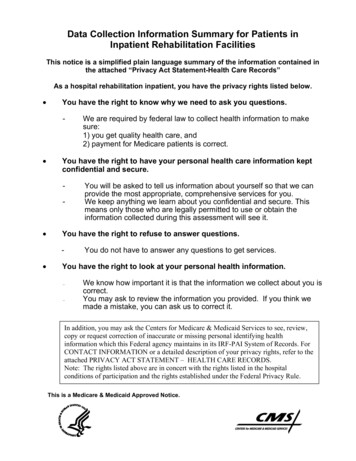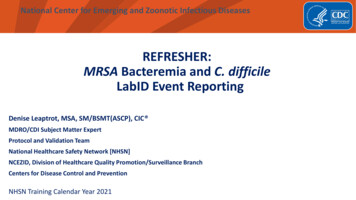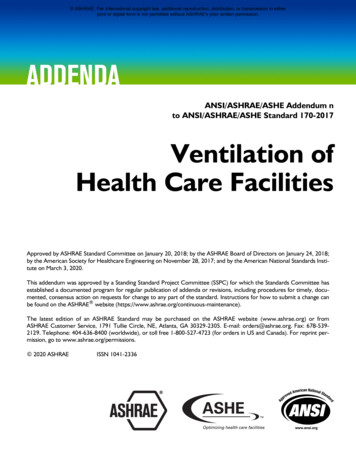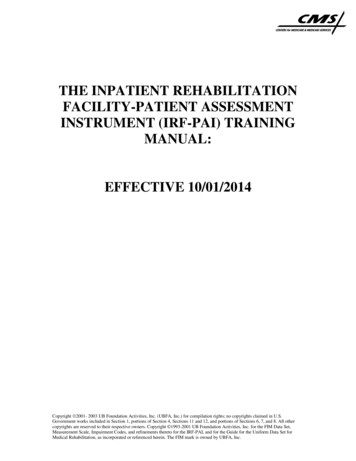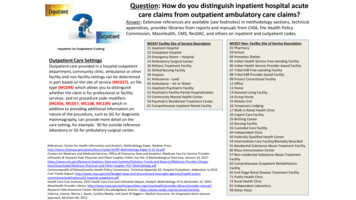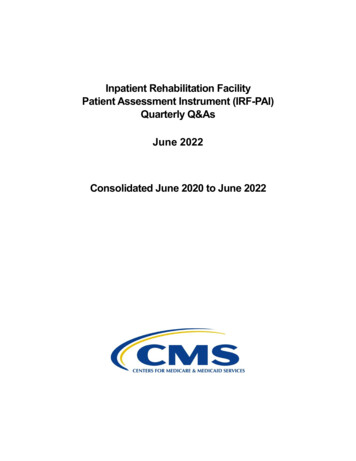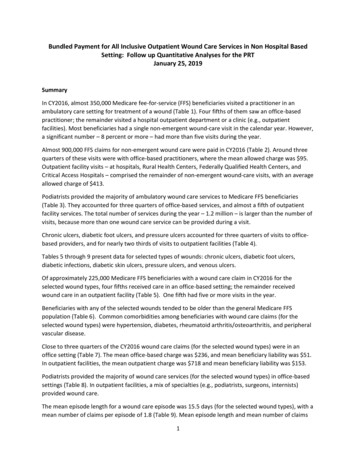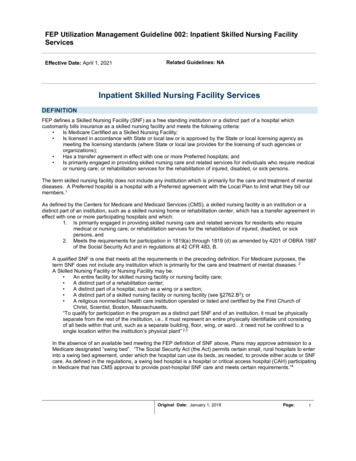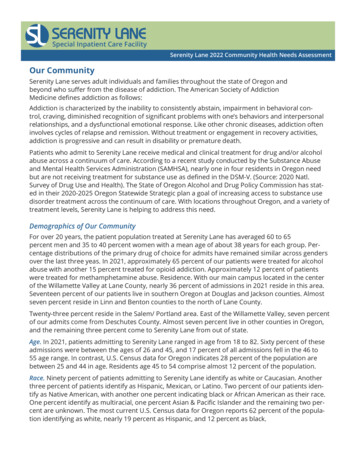
Transcription
Special Inpatient Care FacilitySerenity Lane 2022 Community Health Needs AssessmentOur CommunitySerenity Lane serves adult individuals and families throughout the state of Oregon andbeyond who suffer from the disease of addiction. The American Society of AddictionMedicine defines addiction as follows:Addiction is characterized by the inability to consistently abstain, impairment in behavioral control, craving, diminished recognition of significant problems with one’s behaviors and interpersonalrelationships, and a dysfunctional emotional response. Like other chronic diseases, addiction ofteninvolves cycles of relapse and remission. Without treatment or engagement in recovery activities,addiction is progressive and can result in disability or premature death.Patients who admit to Serenity Lane receive medical and clinical treatment for drug and/or alcoholabuse across a continuum of care. According to a recent study conducted by the Substance Abuseand Mental Health Services Administration (SAMHSA), nearly one in four residents in Oregon needbut are not receiving treatment for substance use as defined in the DSM-V. (Source: 2020 Natl.Survey of Drug Use and Health). The State of Oregon Alcohol and Drug Policy Commission has stated in their 2020-2025 Oregon Statewide Strategic plan a goal of increasing access to substance usedisorder treatment across the continuum of care. With locations throughout Oregon, and a variety oftreatment levels, Serenity Lane is helping to address this need.Demographics of Our CommunityFor over 20 years, the patient population treated at Serenity Lane has averaged 60 to 65percent men and 35 to 40 percent women with a mean age of about 38 years for each group. Percentage distributions of the primary drug of choice for admits have remained similar across gendersover the last three yeas. In 2021, approximately 65 percent of our patients were treated for alcoholabuse with another 15 percent treated for opioid addiction. Approximately 12 percent of patientswere treated for methamphetamine abuse. Residence. With our main campus located in the centerof the Willamette Valley at Lane County, nearly 36 percent of admissions in 2021 reside in this area.Seventeen percent of our patients live in southern Oregon at Douglas and Jackson counties. Almostseven percent reside in Linn and Benton counties to the north of Lane County.Twenty-three percent reside in the Salem/ Portland area. East of the Willamette Valley, seven percentof our admits come from Deschutes County. Almost seven percent live in other counties in Oregon,and the remaining three percent come to Serenity Lane from out of state.Age. In 2021, patients admitting to Serenity Lane ranged in age from 18 to 82. Sixty percent of theseadmissions were between the ages of 26 and 45, and 17 percent of all admissions fell in the 46 to55 age range. In contrast, U.S. Census data for Oregon indicates 28 percent of the population arebetween 25 and 44 in age. Residents age 45 to 54 comprise almost 12 percent of the population.Race. Ninety percent of patients admitting to Serenity Lane identify as white or Caucasian. Anotherthree percent of patients identify as Hispanic, Mexican, or Latino. Two percent of our patients identify as Native American, with another one percent indicating black or African American as their race.One percent identify as multiracial, one percent Asian & Pacific Islander and the remaining two percent are unknown. The most current U.S. Census data for Oregon reports 62 percent of the population identifying as white, nearly 19 percent as Hispanic, and 12 percent as black.
Special Inpatient Care Facility2022 Community Health Needs Assessment page 2Facilities within Our CommunityTo meet the specific treatment needs for localities throughout the state, Serenity Lane has outpatient facilities in the greater Portland area, Salem, Bend, Albany, Eugene and Roseburg, OR as wellas Telehealth services for outpatient programming. Hospital and inpatient services are provided forthese areas at our Coburg campus just north of Eugene.Many other “detox” facilities are meeting the needs of the addicted community throughout Oregonand include: Willamette Family, Eugene; DePaul Treatment Center in Portland; CODA-Tigard Recovery Center in Tigard; Hazelden at Springbrook, Oregon; BestCare Treatment Services in Redmond;New Directions Northwest Inc. in Baker City; Rogue Valley Addictions Recovery Center in Medford;Eastern Oregon Detox Center in Pendleton; Hooper Memorial Center in Portland; Providence HealthSystem Residential Program in Portland; Integrated Health Clinics (opioid treatment only) in Milwaukee; and Bridgeway Recovery Services in Salem. Most acute care hospitals with emergency departments provide these services as well but do not specialize in these services. Serenity Lane is the onlylicensed Specialty Inpatient Care Facility for medically supported withdrawal care in Oregon.Serenity Lane is the only treatment center in Oregon that offers the full continuum of care from detox to residential to outpatient services.Community NeedsAccording to the 2020 National Survey on Drug Use and Health, Oregon ranked second in the country for substance use disorder. In addition, Oregon fell to the very last place in access to treatment.Just over 18 percent of all Oregonians need treatment and do not receive it.To address this addiction crisis, Serenity Lane liaisons with governmental departments, medicalcenters, and substance use treatment centers to meet the health and safety needs of its treatmentcommunity.Community health issues. Some persons struggling with substance use disorders are at risk for contracting tuberculosis, COVID-19 or other transmissible diseases through their lifestyle. In Lane County, community health issues concerning communicable diseases are addressed through the PublicHealth Department.Other patients require medical care that is outside the scope of addiction treatment. Coordination ofpatient care Peacehealth-Riverbend, the closest medical facility to Serenity Lane’s campus, allows fortransfer of addicted patients to Serenity Lane after stabilization.To be successful, addiction treatment centers must adapt to the varied needs of those people seeking care. Some patients with a problem of opioid abuse, for instance, require a longer treatmentregimen than is usually the norm. In July 2018, Serenity Lane added Medication Assisted Treatmentto meet this need beyond the completion of the patient’s residential stay. In 2021, Serenity Laneexpanded its evidence-based treatment offerings in our residential facility to provide individualizedcare for our patients to meet their specialized needs due to trauma and other mental health issues.
Special Inpatient Care Facility2022 Community Health Needs Assessment page 3A further example is day treatment. To accommodate the employment issues of our patients,Serenity Lane offers partial hostpitalization that is more flexible for our patients’ work schedulesand responsibilities. Providing this modality is also an acknowledgment of changing insuranceprocesses as insurers modify the treatment coverage for their subscribers. In 2019, we alsointroduced mental health and medication management services at our Eugene Outpatient officein order to accommodate more patients needing continuing care.Regarding treatment during the Covid-19 pandemic, we responded by offering Telehealth for all ofour outpatient programming, reaching more people throughout the state and working closely withLane County Public Health and Oregon Health Authority to establish protocols allowing us to continue to provide treatment services.Community education. Dr. Eric Geisler, Director of Medical Services at Serenity Lane, regularly travelsthroughout the state of Oregon to deliver addiction lectures to stakeholder groups like the ILWU,Deschutes County, Trillium Lane County, and the Oregon Medical Group. In May of 2021 Dr. Geislerpartnered with Dr. Kate Marshall from Oregon Health Sciences University to present an educationwebinar pertaining to issues specific to women and alcohol use.Serenity Lane has partnered with a local interventionist to present monthly webinars to the community about how to identify if someone is struggling with a substance use disorder and get them intotreatment. These webinars have been attended by business owners, family members and representatives from public health agencies and other nonprofits. Between these and regular facility tours,we hope to demystify treatment for those who need it.There was no community commentary on earlier Community Health Needs Assessment reports.Serenity LaneAs Serenity Lane patients transition through each level of care, they learn how to identify the day-today triggers that can be pitfalls to recovery and receive tools and strategies beneficial to combattingaddiction. For most patients, addiction is a symptom that overlies a deeper trauma experienced inthe past. Through recognizing this, trauma patients are better able to create coping mechanisms that are free of the desire to self-medicate.For over two decades, Serenity Lane has offered long-term outpatient treatment that encouragespatients to maintain a connection with the therapeutic and increase changes of sustained recovery.About half of the patients who complete the outpatient program transition to this level of carewhere they share mutual problems and develop solutions as a group.Care coordination. During the initial assessment, though, some patients reveal other needs that arebeyond the scope of Serenity Lane’s care. Patients with deeper issues arising from serious medicalor mental health conditions receive referrals to other quality providers within the local areas.
Special Inpatient Care Facility2022 Community Health Needs Assessment page 4Serenity Lane offers mental health services for those patients who need it and continues to lookfor ways to expand these services. According to Brittany Ferrell, MPH, a clinician with A Mission forMichael:“Our community continues to need appropriate treatment options for true dual-diagnosis clients, especially for those who also suffer from more acute mental illness along with SUD. People seeking treatment usually do not have multiple opportunities to seek care as it can be both a considerable investment in terms oftime and finances. Access to behavioral health resources in our community can be a challenge, however, Itis critical for treatment organizations to recognize and triage clients appropriately based on presentation.”Over the past two years, Serenity Lane has partnered with Medicaid Coordinated CareOrganizations (CCOs) providers across a large geographic area in the state of Oregon such asUmpqua Health Alliance, Pacific Source Community Solutions, and other CCOs. These partnershipshave helped us serve more members of the low income population in Oregon. It is estimated that atleast 40% of Oregonians are eligible for Medicaid.Another example of care coordination is the annual Community Service Awards Breakfast hostedsince 2012 by Serenity Lane. Service providers throughout the Pacific Northwest nominate individuals working in the drug and alcohol field who deserve recognition for their contributions. Past awardrecipients have ranged from police officers to volunteers to community partners. In short, peoplethroughout the continuum of care in the region are recognized for their integral support in meetingthe local community’s needs to address the illness of addiction.Community members. Lastly, Serenity Lane patients are surveyed at each level of care and afterdischarge to gather their input on patient programming. These tools identify ways to improve thequality of care, give opportunities for patients to identify personal needs in recovery, and discusswhat is and is not working well in their treatment regimen.The FutureSerenity Lane remains committed to its mission of transforming lives through the treatment of addiction. We will always attempt to employ the most appropriate tools to achieve positive outcomesincluding periodically updating our Community Health Needs Assessment.Addiction is a disease of the family and, by extension, a disease of the community. An importantcomponent of Serenity Lane’s philosophy is to affirm the inherent dignity and worth of its patientsand family members as part of the treatment community. As long as families in addiction crisis exist,Serenity Lane will strive to improve their quality of life by giving them the tools to manage the illnessof addiction.See Attachment A for referenced data.
Special Inpatient Care Facility2022 Community Health Needs Assessment page 5Attachment AAll data is from 2021 Serenity Lane active patients.
Special Inpatient Care Facility2022 Community Health Needs Assessment page 6
Special Inpatient Care Facility2022 Community Health Needs Assessment page 7
Special Inpatient Care Facility2022 Community Health Needs Assessment page 8
Serenity Lane is the only treatment center in Oregon that ofers the full continuum of care from de-tox to residential to outpatient services. Community Needs According to the 2020 National Survey on Drug Use and Health, Oregon ranked second in the coun-try for substance use disorder. In addition, Oregon fell to the very last place in access to .



